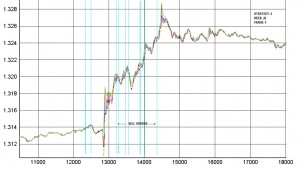Here we give some examples of test scenarios we use in our Strategy Testing Methodology.
We use most important price action patterns as strategy test scenarios. This approach improves testing efficiency, because it concentrates on smaller data of higher relevancy.
Example #1: Trending Market
This pattern is very important because trends have the biggest profit potential. If the trading strategy can reliably make use of the trend, it alone might be sufficient. According to well-known Pareto principle, we can assume that 20% of trades brings 80% of profit. And during trending markets is obviously the time for these winning trades.
However, implementing a successful trading algorithm for the trend is not an obvious task. First of all, it might take some time and losses to get a winning position. Markets never move in a straight line, and during the powerful trend, the counter-trend pull-backs can be very sharp as well. Which can trigger a stop-loss for the position just taken, so the market needs to be re-entered.
Moreover, even after the trend is confirmed, it is still impossible to predict how far markets can go. Imagine that we have successfully taken a position in the direction of the trend and after some time the stop-loss order was triggered during a reversal. We fixed some profit. Should we enter the markets again? It is a guesswork. So the purpose of the trend strategy test Scenario is to check whether the automated trading system implements some trade-off between profit from the trend and losses from failed attempts to predict when it has ended.
Example #2: Price Action Patterns Change. A Sudden Trend
One of the most difficult tasks of the Forex trading is anticipating when price action patterns change and applying the trading strategy most relevant at given time. One can imagine that this task is far more difficult for Automated Trading Strategies, as they only execute their algorithm.
For the range-bound (flat) market, trading robots using oscillators (e.g. RSI) usually perform well. But oscillators are themselves unable to identify a trend. In this situation a profitable Trading Robot must have some internal mechanism of loss control – unless it has some Manual or Automated Trading Strategy changing mechanism in place.
The Figure below shows the interchanging price action patterns: a powerful uptrend suddenly begins in previously calm market. We see the markets gaining over 150 pips within less than an hour. Please note that the numbers on the X-axis are not seconds but ticks. And in fast-moving markets Trading Server can often send multiple ticks per second.

Vertical blue lines show the SELL orders that the Expert Advisor under test placed in an attempt to take a winning position at the possible peak. The trading strategy under test was simple RSI-based reverse-to-the-mean and didn’t have any intelligense to switch to the trend mode. We can notice that the pivot point signals the algorithm generated were actually quite decent. If the market did top around them, these short positions could have had solid profit potential. However, as the trend was continuing, all positions were closed due to stop-losses. Eventual result was losing money.
This scenario can help understand whether an Automated Trading Strategy can automatically adapt to the changing market conditions. Namely, whether it can switch to the Trading Mode making use of the trend. In the case Trending Mode is not supported or doesn’t work properly, another important pass/fail criterion is whether the Trading System has some loss control mechanism in place, which will force it to exit the market in such case.
Example #3: Events Driven Price Action Patterns
Sometimes the markets can jump a hundred pips within seconds. This is what often happens around major news releases. It is known that many traders close all positions by that time, as those events are scheduled. However, an unpredicted event can happen at any time that can move markets drastically. An example is the fake tweet about the White House bombing posted by Syrian hackers in April 2013.
Quite often the markets can move over 100 pips so fast that during that time Trading Server can literally only send 2-3 quotes. So placing orders to try to profit from the move might be virtually impossible. More importantly, sometimes even stop-loss orders might not be triggered. There are different price action patterns: in some cases, markets first jump in one direction, and then quickly reverse with even more power.
This Test Scenario can be classified as negative or destructive testing. If the strategy has some defence mechanism in place to, this is one of the real life scenarios to test its efficiency.
Example #4: Low Volatility Price Action Pattern
Even though markets always move, sometimes the moves are smaller. The best example is the Asian session (23 to 8 GMT). This is also a viable use case to test trading strategies.
Books:
Algorithmic Trading: Winning Strategies and Their Rationale (Wiley Trading)
Lien on Forex Trading: The Complete Guide to Profitable Trading Strategies (Wiley Trading)